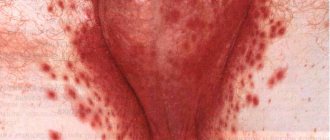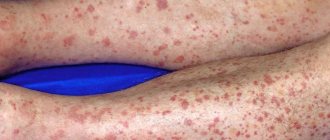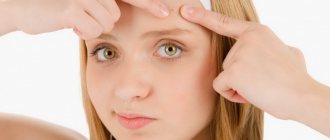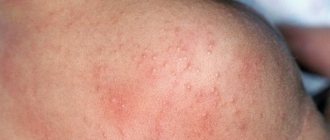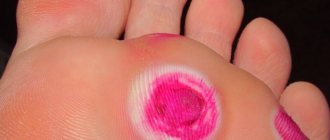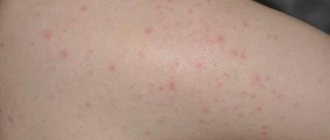Few people know that acne can appear on the décolleté area as often as on other parts of the body, causing girls and women a lot of grief and worry. But in order to effectively deal with such manifestations, it is important to know exactly their causes, which are quite diverse.
Such rashes can appear at any age, sometimes taking on a focal form. Getting rid of acne is not easy, but this problem cannot be left unattended, regardless of the extent of the formation.
Causes of acne in the décolleté area
In fact, acne often appears on the décolleté area, but very few women pay enough attention to this problem and turn to specialists. In most cases, girls simply hide the rashes under clothes, waiting for everything to go away on their own, only occasionally applying some kind of emollient cream, without thinking about their etiology.
The causes of acne on the chest are varied, but most often it is:
- Insufficient hygiene procedures or neglect of personal hygiene rules.
- Disturbances in the functioning of the reproductive and endocrine systems.
- Insufficient skin care or use of inappropriate products.
- Changes in hormonal levels, both natural and pathological. Often, acne on the décolleté appears before or during menstruation, during pregnancy. In adolescents, such rashes occur during puberty, in older women - during menopause, which is also associated with changes in hormonal levels.
- Blockage of sweat and sebaceous glands, for example, when using fatty body cream or cosmetic powder.
- Wearing too tight, tight-fitting clothes made of synthetic fabrics that do not allow air to pass through. In this case, a violation of thermoregulation processes occurs.
- The presence of diseases of the digestive system, as well as the kidneys and liver.
- Eating disorders, non-compliance with food regimen and a certain diet. Abuse of sweets, as well as fried, smoked, pickled and fatty foods.
- Having an allergic reaction to any medications, cosmetics, food or synthetics.
- Constant stress and nervous disorders.
- Frequent colds and infectious diseases, vitamin deficiency, against the background of which a general decrease in immunity occurs.
- The presence of infectious diseases of a dermatological nature.
Seborrhea and keratosis - causes of rashes on the shoulders and forearms
During hormonal changes in the body, the endocrine system works under heavy loads. An excess amount of steroids enters the blood, and the activity of the sebaceous glands of the skin increases, characteristic of oily seborrhea. Microscopic sacs secrete an oily secretion through the canal of the hair follicle. Its blocking by keratin, dirt, sebum leads to inflammation, papulopustules appear - the main elements of acne (vulgar, medicinal and other types).
Peels and scrubs cleanse the epidermis of dead cells, making the skin soft and velvety. Wraps with honey or seaweed have the same effect. A solution of apple cider vinegar and a decoction of birch buds perfectly dissolve excess keratin.
READ ALSO: Has anyone reduced testosterone using folk remedies, a question for women Forum
The popular name for the disease is “goose bumps”, given for the rough surface of the arms, legs and buttocks. The medical term "follicular hyperkeratosis" means excessive accumulation of horny substance. Dense dry bumps appear on those parts of the body where there are many hair follicles.
Improve the condition of goose bumps on the forearms:
- ointments “Diprosalik”, “Akriderm SK”, lotion “Belosalik” (externally);
- oral intake of vitamin A and ascorbic acid;
- compresses with salicylic acid 2%.
Bathing procedures with birch and oak brooms, herbal poultices with chamomile are good for acne on the back and shoulders.
Types of acne on the décolleté area
Depending on the specific cause, chest rashes can have different appearances, for example:
- Be red. Such pimples usually densely cover the surface of the skin, often forming an almost continuous lumpy red spot, indicating an active inflammatory process. Such acne can cause a person a lot of inconvenience and discomfort, causing not only itching and a burning sensation, but also causing pain. Most often, this type of rash accompanies allergic manifestations, but it can also occur when thermoregulation is impaired, when the skin is not able to fully breathe. In this case, the rash spreads to the skin area under the mammary glands, as well as between them.
- To be white. These pimples are small bumps that show no signs of inflammation. They are called closed comedones. These rashes form due to improper care, when keratinized cells accumulate on the surface and the sebaceous ducts become clogged.
- Be purulent. The process of suppuration begins in cases where bacteria penetrate closed comedones and cause inflammation. Such manifestations are usually observed due to poor hygiene or the presence of serious hormonal disorders. Often this type of acne becomes a companion to diseases of the endocrine system, for example, diabetes. Therefore, if you find such elements on the chest area, you should consult a doctor.
- Be subcutaneous. Basically, these elements appear with a significant decrease in general and local immunity, resulting from a lack of hygiene procedures. The second reason for their appearance may be the penetration of parasites into the skin, in particular demodex mites.
Treatment of acne in the décolleté area
Many women, instead of using medications and cosmetics to eliminate unpleasant elements, resort to the usual squeezing out of the contents. Of course, manual skin cleansing is very popular in beauty salons and is effective in combating this problem, but you shouldn’t do it yourself. To carry out this procedure correctly, it is necessary to meet several special conditions, if violated, the wounds left from acne can become infected, and after they heal, scars often remain.
For this reason, it is not recommended to clean the skin manually; it is better to seek help from traditional or folk medicine.
It is important to remember that by prescribing treatment yourself, you can cause serious harm and significantly worsen the situation. In addition, it is important to accurately establish the cause of acne on the décolleté, since therapy should be aimed specifically at eliminating the cause and treating its consequences, otherwise it will be ineffective. Therefore, it is necessary to contact a doctor and undergo a prescribed examination for an adequate selection of medications, which is individual in each case.
Drug therapy
Treatment of acne on the chest with the help of medications requires an integrated approach, just as when eliminating such elements on the face. It is important not only to cure existing manifestations, but also to have a full impact on the cause of the rash, as well as change your lifestyle, give up bad habits and balance your diet.
Different remedies can be prescribed to combat acne on the skin of the chest, because in each case the approach to treatment is individual and depends not only on the causes, but also on the characteristics of the body. Most often, patients are prescribed:
- External use agents to eliminate the inflammatory process, such as Zinc, Syntomycin, Ichthyol, Sulfur, Heparin, Salicylic ointments, as well as Solcoseryl, Levomekol.
- Ointments with an antibacterial effect, in particular: Zinerit, Baneocin, Tetracycline, Liniment Sintomycin, Erythromycin, Dalatsin. Ointments based on erythromycin and chloramphenicol.
- Ointments of the hormonal category can quickly rid the skin of emerging acne, but such products have a big drawback - they slow down the skin renewal process. In addition, they are prohibited from being used by women expecting a baby and nursing mothers. These ointments include: Celestoderm, Sinaflan, Adventan.
- Treating the skin with antiseptic solutions, for example, Chlorhexidine, Miramistin or fresh hydrogen peroxide.
- Treatment with alcohol solutions with normal tolerance. Such agents have not only an anti-inflammatory, but also a drying effect. These include: calendula tincture, Levomycetin, Boric and Salicylic alcohol.
In case of an allergic rash, the patient is also prescribed tablet forms of antihistamines, depending on the characteristics of the allergy. Such drugs have different active ingredients, so only a doctor should prescribe them. Self-selecting antihistamines poses a serious health hazard. The simplest and almost universal drug in this category can be called Loratadine.
In some cases, the doctor prescribes special “talkers” to the patient, combining several drugs with different effects. Such products are prepared in special pharmacies strictly according to a doctor’s prescription.
ethnoscience
Alternative medicine for removing acne shows a fairly high level of effectiveness, but at the same time they have fewer contraindications compared to most medications and rarely cause side effects.
The simplest remedy can be called ordinary tar and laundry soap 70 - 72%. The foam of these types of soap has a powerful antibacterial effect and helps cleanse the skin of dead cells, allowing it to breathe normally. This soap can be used as the main means for washing the body or 1-2 times a week apply foam as a compress for 10-15 minutes, preventing it from drying out. During the treatment of acne, it is recommended to make such masks 2 or 3 times a day.
Aloe juice is also an effective remedy. It is important here that the plant is at least 3 years old, since until this time it does not have full healing power. Several fleshy leaves of the plant should be crushed, put the mixture in a clean cloth and apply a compress to the problem area for 20 minutes. You can simply wipe the skin with acne with fresh plant juice twice a day.
Compresses made from decoctions and water infusions of some medicinal herbs, for example, calendula or chamomile flowers, celandine, and sage, also help in eliminating acne. Such products can quickly soothe inflamed skin, stop the development of infection, help cleanse pores and eliminate dead cells. Lotions and compresses from medicinal decoctions should be applied 2 - 3 times a day for 20 - 30 minutes.
You can also prepare a special homemade tonic, the use of which has a pronounced antibacterial effect. To do this, take freshly squeezed lemon juice and clean (filtered or boiled) water. For 1 part lemon juice you need to take 3 parts water. You need to apply this tonic to problem areas of the skin twice a day, using cotton pads. It is important to prepare a fresh portion of the product every day.
Saline solution deserves special attention. When prepared correctly, this simple remedy can heal a person from many ailments, including acne. A solution containing a concentration of human tears has medicinal properties, but at home it is very difficult to calculate the ideal proportions. For lotions and wipes, you can use a solution prepared at the rate of 1 teaspoon of salt (preferably sea salt) per glass of warm boiled water. Treatment of problem areas of the skin is carried out twice a day.
Often, masks made from different types of cosmetic clay are used to combat acne, which should be prepared according to the instructions on their packaging. The mass is applied to the skin for about 20 minutes, after which it is gently washed off with water, avoiding rubbing the surface of the skin. The procedure is carried out 2 – 3 times a week.
Turmeric
Turmeric is good for treating any type of acne due to its antibacterial and antioxidant properties. Its anti-inflammatory nature also helps reduce redness and inflammation caused by acne.
Additionally, it helps fade acne scars.
- Mix 1 teaspoon of turmeric powder with enough rose water to make a paste Apply the mixture to the acne area and leave for 15 to 20 minutes Use warm water to cleanse the paste Repeat this once or twice a day.
- Alternatively, mix 1 teaspoon turmeric powder, 1 teaspoon honey and 2 teaspoons milk Apply the mixture on the affected area Let it dry, then wash the area with warm water Use this remedy 2 or 3 times a week.
Recipes for ointments and scrubs for acne
At home, you can prepare special products that help effectively fight acne on the face, décolleté and other parts of the body. The most effective of them are:
- A combination of 3 parts olive oil, 2 parts natural beeswax, mixed thoroughly. Then add a little lecithin and 2 capsules of vitamin E to this mixture. To increase efficiency, you can pour in a little aloe vera juice or use its pharmacy gel form. The cream must be thoroughly mixed, transferred to a clean sealed jar and stored in the refrigerator for about a month, applied to the skin daily after cleansing procedures.
- A mixture of sour cream in the amount of 1 glass with a teaspoon of lemon juice, two tablespoons of fresh cucumber juice, 100 grams of cologne and two raw yolks of chicken eggs. The mixture must be beaten in a mixer or blender, transferred to an airtight jar and placed in the refrigerator. Apply every day.
- Honey and orange scrub. To prepare, mix crushed orange zest with natural liquid honey in equal proportions, adding 1 pinch of ground red pepper and cinnamon to the mixture. Apply the mixture to problem areas, leave for 3-5 minutes, then gently but thoroughly massage and rinse with water.
- A bran mask in combination with several components also works well to get rid of acne. To prepare, take 1 tablespoon each of wheat bran, semolina, natural honey, colorless henna powder and fresh lemon juice. Mix the mixture and add the raw yolk. Mix again until smooth and apply to the problem area, leaving for 20 minutes. The scrub mask should be washed off after drying. To do this, you need to wet your hands with warm water, moisten the dried composition, then intensively massage the skin with your hands and rinse with water.
Check out other acne masks here.
Consequences
In most cases, acne in the décolleté area is not dangerous unless its appearance is associated with any serious illness. But if such rashes are left untreated, some complications may arise.
In most cases, the consequences occur when squeezing pimples instead of using cosmetics and medications. In this case, small scars often appear associated with mechanical damage to delicate skin, and dark spots similar to pigmentation. Such spots occur due to increased melanin production in the area where the pimple was squeezed out. Such consequences do not decorate the body at all, and it is very difficult to get rid of them.
The same complications can occur with incorrectly selected treatment or self-therapy without consulting a professional doctor.
It is also important to remember that when squeezing out pimples, a small wound is formed (skin damage), which allows free access to the body for all kinds of pathogenic bacteria, which not only cause an intense inflammatory process, but can also provoke the appearance of various infectious diseases when they penetrate the blood system.
Preventive measures
To keep the skin clean and healthy in the décolleté area, it is necessary to follow a number of preventive measures, because the appearance of acne is easier to prevent than to try to cure. To do this, you just need to follow a number of rules:
- When cleaning the skin of the face and neck area, it is important not to forget about the décolleté area. It is recommended to apply scrubs and special cleansing products to the chest and neck area while taking a shower, finishing with a contrast shower.
- It is important to use only natural and high-quality cosmetics.
- It is necessary to balance your diet, providing the body with all nutrients, vitamins and microelements, including fermented milk products, fresh fruits in the diet, changing the cooking method to boiling, baking or steaming.
- It is important to wear only high-quality clothing made from natural fabrics in the correct size, avoiding tight fitting or constriction.
- There is no need to squeeze out pimples; this violates the integrity of the skin and leads to the formation of unaesthetic scars and blemishes.
- In case of severe rashes, you should immediately contact a qualified doctor.
Of course, in itself, the appearance of acne on the décolleté area does not pose a serious danger, but it can lead to the formation of cosmetic defects of the skin, which will affect the overall appearance. Therefore, it is important to consult a dermatologist in a timely manner and carry out adequate treatment.
Acne on the shoulders and décolleté - a variety of causes
It happens that due to friction with clothing, hair follicles are damaged, redness begins, and swelling of the skin area develops. When such irritants are exposed for a long time, the back and shoulders will constantly be covered with red pimples.
If a rash suddenly appears on the shoulders and chest, the reasons can be very different:
- poor diet, a lot of sweet and soy products in the diet;
- seasonal weather changes, unfavorable climate;
- high cortisol levels during stress;
- removal of toxins through the skin;
- excessive sweating;
- stale bed linen.
Women often suffer from acne on the décolleté and shoulders during the premenstrual period and during pregnancy. Depression, anxiety and dieting also negatively affect skin condition. Contact dermatitis often occurs after using low-quality perfumes, hair shampoos, or wearing jewelry.
